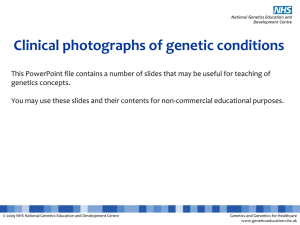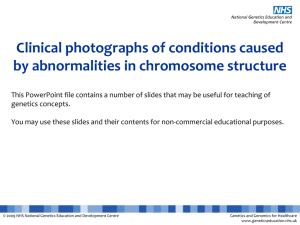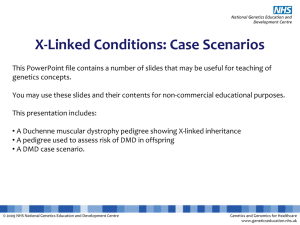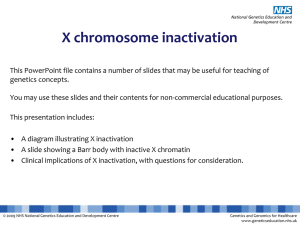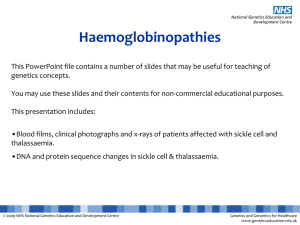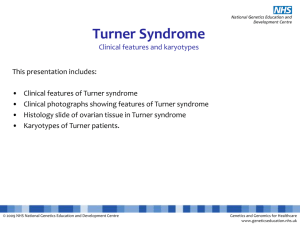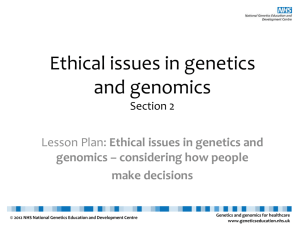Classification of genetic disorders
advertisement
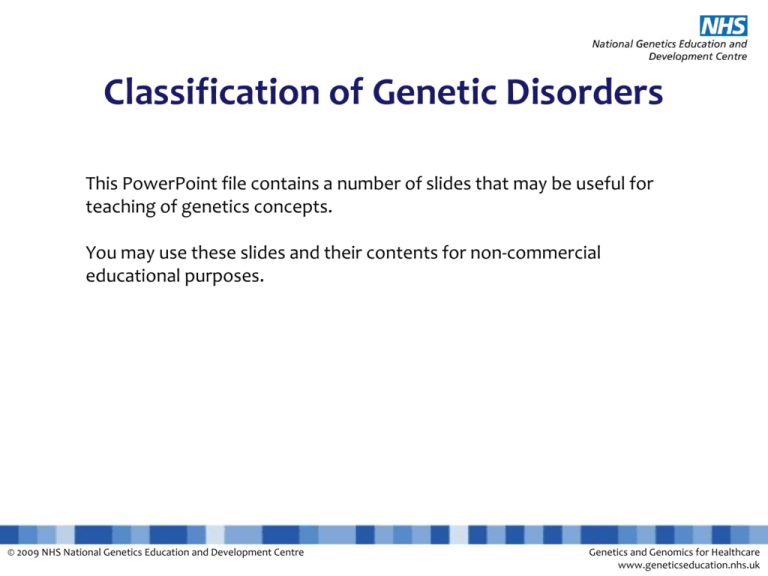
Classification of Genetic Disorders This PowerPoint file contains a number of slides that may be useful for teaching of genetics concepts. You may use these slides and their contents for non-commercial educational purposes. © 2009 NHS National Genetics Education and Development Centre Genetics and Genomics for Healthcare www.geneticseducation.nhs.uk Etiology of diseases. For any condition the overall balance of genetic and environmental determinants can be represented by a point somewhere within the triangle. Fig. 13.3 ©Scion Publishing Ltd © 2009 NHS National Genetics Education and Development Centre Genetics and Genomics for Healthcare www.geneticseducation.nhs.uk Classification of genetic disorders • Multifactorial + environment • Single gene Male • Chromosomal • Mitochondrial • Somatic mutations (cancer) © 2009 NHS National Genetics Education and Development Centre Genetics and Genomics for Healthcare www.geneticseducation.nhs.uk Continuum of penetrance. There is a continuum of penetrance from fully penetrant conditions, where other genes and environmental factors have no effect, through to low-penetrance genes that simply play a small part, along with other genetic and environmental factors, in determining a person’s susceptibility to a disease. Multiple sclerosis is used as an example of a multifactorial condition where genetic factors play a major part in determining susceptibility, but current research suggests that each individual factor has a very low penetrance. Fig. 1.15 ©Scion Publishing Ltd © 2009 NHS National Genetics Education and Development Centre Genetics and Genomics for Healthcare www.geneticseducation.nhs.uk Genetic factors Mutations in single genes (often causing loss of function) Male Variants in genes causing alteration of function Chromosomal imbalance causes alteration in gene dosage © 2009 NHS National Genetics Education and Development Centre Genetics and Genomics for Healthcare www.geneticseducation.nhs.uk Classification of genetic disorders Single Gene Disorders Mutations in single genes Male Multifactorial diseases Variants in genes + environment Chromosome disorders Chromosomal imbalance © 2009 NHS National Genetics Education and Development Centre Genetics and Genomics for Healthcare www.geneticseducation.nhs.uk Dominant Heterozygotes with one copy of the altered gene are affected Recessive Homozygotes with two copies of the altered gene are affected X-linked recessive Males with one copy of the altered gene on the X-chromosome are affected Male © 2009 NHS National Genetics Education and Development Centre Genetics and Genomics for Healthcare www.geneticseducation.nhs.uk Genetic disorders • Multifactorial (common) - “Environmental” influences act on a genetic predisposition to produce a liability to a disease. - One organ system affected. - Person affected if liability above a threshold. • Single gene (1% liveborn) - Dominant/recessive pedigree patterns (Mendelian inheritance). - Can affect structural proteins, enzymes, receptors, transcription factors. • Chromosomal (0.6% liveborn) - Thousands of genes may be involved. - Multiple organ systems affected at multiple stages in gestation. - Usually de novo (trisomies, deletions, duplications) but can be inherited (translocations). © 2009 NHS National Genetics Education and Development Centre Genetics and Genomics for Healthcare www.geneticseducation.nhs.uk The contributions of genetic and environmental factors to human diseases Haemophilia Osteogenesis imperfecta Club foot Pyloric stenosis Dislocation of hip Duchenne muscular dystrophy GENETIC Phenylketonuria Galactosaemia Rare Genetics simple Unifactorial High recurrence rate © 2009 NHS National Genetics Education and Development Centre Peptic ulcer Diabetes Tuberculosis ENVIRONMENTAL Scurvy Spina bifida Ischaemic heart disease Ankylosing spondylitis Common Genetics complex Multifactorial Low recurrence rate Genetics and Genomics for Healthcare www.geneticseducation.nhs.uk • Multifactorial “Environmental” influences act on a genetic predisposition One organ system affected • Single gene Dominant/recessive pedigree patterns Structural proteins, enzymes, receptors, transcription factors • Chromosomal Multiple organ systems affected Inherited or de novo • Environmental Drugs, infections © 2009 NHS National Genetics Education and Development Centre Genetics and Genomics for Healthcare www.geneticseducation.nhs.uk Single gene disorders I:1 AA High risks to relatives Dominant/recessive pedigree patterns Some isolated cases due to new dominant mutations Structural proteins, enzymes, receptors, transcription factors I:2 AB I:1 II:1 II:1 AA II:2 AB II:2 I:2 II:3 II:5 II:6 II:8 II:3 BB III:1 ? I:1 III:1 BB Tom I:2 III:2 I:3 IV:1 II:1 III:1 IV:1 IV:2 II:2 II:3 III:2 III:3 IV:3 II:4 II:5 III:4 IV:4 IV:5 II:6 III:5 IV:6 © 2009 NHS National Genetics Education and Development Centre II:7 II:8 III:6 IV:7 III:7 IV:8 IV:9 II:9 III:8 IV:10 II:10 II:11 II:12 II:13 III:9 III:10 III:11 III:12 IV:11 II:14 III:13 IV:12 II:15 III:14 III:15 III:16 III:17 IV:13 Genetics and Genomics for Healthcare www.geneticseducation.nhs.uk
